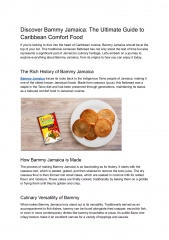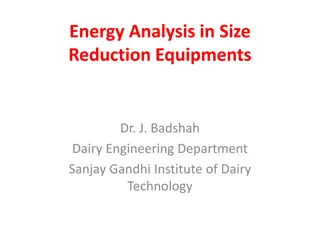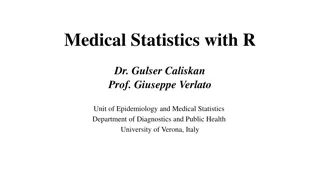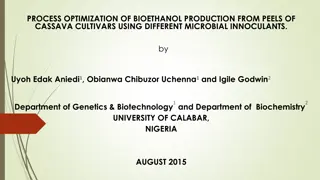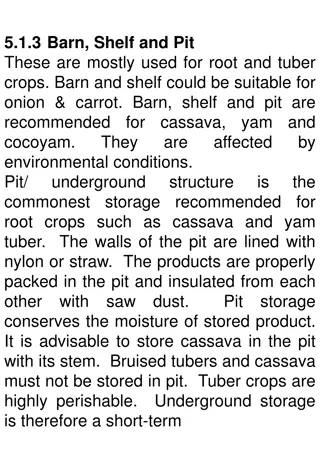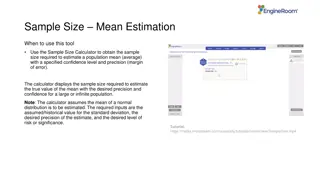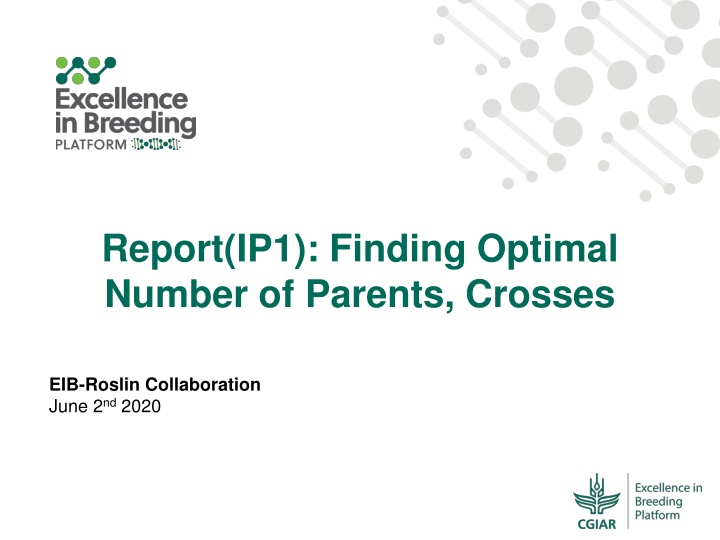
Optimal Number of Parents for Genetic Gain in EIB-Roslin Collaboration
Explore the impact of increasing the number of parents in a breeding program on genetic gain over time. The study compares different breeding strategies and highlights a sweet spot for the number of parents. Discover the results and implications for maximizing genetic diversity in crop breeding.
Download Presentation

Please find below an Image/Link to download the presentation.
The content on the website is provided AS IS for your information and personal use only. It may not be sold, licensed, or shared on other websites without obtaining consent from the author. If you encounter any issues during the download, it is possible that the publisher has removed the file from their server.
You are allowed to download the files provided on this website for personal or commercial use, subject to the condition that they are used lawfully. All files are the property of their respective owners.
The content on the website is provided AS IS for your information and personal use only. It may not be sold, licensed, or shared on other websites without obtaining consent from the author.
E N D
Presentation Transcript
Report(IP1): Finding Optimal Number of Parents, Crosses EIB-Roslin Collaboration June 2nd2020
Baseline 4 Parents, 12 crosses: 4 = 2- way, 4 = selfed, 4 = OP P1 x P2 Crossing Seedling Nursery 1,632 = 12 crosses * 136 progeny 1588 (1*5m plots, 1 loc, 1 rep) F1-CE 120 (3*5m plots, 2 loc, 2 reps) F1-PYT F1-AYT 64 (6*7m plots, 2 loc, 3 reps) F1-UYT 24 (6*7m plots, 2 loc, 3 reps) F1-UYT2 15 (6*7m plots, 3 loc, 3 reps)
1. Introduction to the problem Crop by Region IITA-EACassava Problem Specification Currently, only four parents are used. Too few parents may make it difficult to maintain adequate diversity required to increase genetic gain over time Breeding strategy component tackled Crossing / Evaluation / Selection Breeders equation terms tackled a , i, L Hypothesis Increasing the number of parents in the program will lead to increased genetic gains over time
2. Materials and Methods Treat Description Use of current #parents, #crosses, #progeny (4 parents, 12 crosses, 136 progeny). Parents recycled from PYT and AYT (mixed crossing block) T1 (Baseline) A grid of different combinations of nParents(4-64), nCrosses(6-816, [n(n- 1)/2], nProgeny determined by restricting genotypes to1632. Parents recycled from PYT and AYT (mixed crossing block) T2 (Grid) nParents (4-64), largest nCrosses/nParents and nProgeny determined by restricting genotypes to 1632. Recycling new parents at PYT, AYT and PYT+AYT were compared. T3 (PYT/AYT) Simulation: 20-year burnin based on the current scheme (Baseline), and followed by 20-year and 60-year period of breeding for each treatment varGxY assumed = varG Plant H2= 0.01, row H2= 0.2 and plot H2= 0.5 Genetic gain and relative variance tracked at F1
3. Results Genetic gain at F1: T1&T2(Grid: [n(n-1)]/2: #F1 = 1632) There is a plateau to the number of crossCombs: <nParents do not allow reaching this plateau With a longer breeding period, the comparative advantage of <nParents diminishes There is a sweetspot for nParents No need to do all possible crosses, just sampling % of crosses is adequate.
3. Results Genetic gain at F1: T1&T2(Grid: [n(n-1)]/2: #F1 = 1632) Table: Summary of nParents, nCrosses and nProgeny combinations from the results from the previous slide. Number of genotypes (nIndTotal) remains constant based on the program size. The blue color indicates where the plateau of the scenarios lies nParents 4 8 8 8 16 16 16 16 16 32 32 32 32 32 32 32 64 64 64 64 64 64 64 64 nCrosses 6 6 12 24 6 12 24 48 96 6 12 24 48 96 204 408 6 12 24 48 96 204 408 816 nProgeny 272 272 136 68 272 136 68 34 17 272 136 68 34 17 8 4 272 136 68 34 17 8 4 2 nIndTotal 1632 1632 1632 1632 1632 1632 1632 1632 1632 1632 1632 1632 1632 1632 1632 1632 1632 1632 1632 1632 1632 1632 16321632 Based on the results presented on the previous slide, Optimal nParents ranges from 16-32 Optimal nCrosses ranging from 96 204 depending on nParents Optimal nProgeny per cross ranging from 8-17 depending on nCrosses
3. Results Genetic gain at F1: T3(Largest nCrosses/nParent: #F1 = 1632) Given the current evaluation strategy, it is better to select new parents from both PYT and AYT.
4. Conclusion 1. Even though <nParents appears to sustain genetic gains, for medium to long term objectives, it is advisable to find a sweetspot for parents that allows sustained genetic gains and enough diversity to adapt to changing situations. 2. The data suggests this sweetspot to be between 16-32 nParents for this program and the nCrosses nCrosses/nProgeny Combs should be managed such as to allow optimal sampling of the diversity (nCrosses) and the value of each cross(nProgeny) between 96-204. However, 3. Given the current evaluation strategy and accuracy, recycling parents from both PYT and AYT is optimal. After deciding on nParents, a follow up IP may be to examine recycling at PYT and AYT using a different evaluation strategy.
Thank you for your interest!


